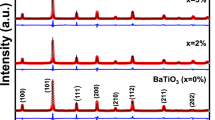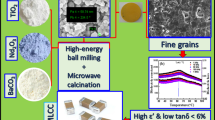Abstract
Compositions in the (1 − x)CaTiO3–xCa(Ta1/2Ga1/2)O3 (x = 0.4, 0.45, 0.50, 0.55) series were processed through a solid-state mixed-oxide route. X-ray diffraction (XRD) of x = 0.5 and 0.55 compositions revealed the formation of single-phase ceramics with orthorhombic (Pbnm) symmetry. At x ≤ 0.45, a couple of low intensity XRD peaks matching PDF# 04-002-5066 for Ca3TiTaGa3O12 were also observed which indicated second-phase formation. The microstructure of the sintered pellets for x = 0.5 and 0.55 compositions comprised densely packed irregular-shaped large grains with uniform contrast. The unit cell volume increased with increasing Ta5+ and Ga3+ contents at the B-site, which caused a decrease in both the relative permittivity (ε r) and temperature coefficient of resonance frequency (τ f) but an increase in quality factor (Q × f o). The optimum microwave dielectric properties (i.e., ε r ~ 47, Q × f o ~ 26,630 GHz and τ f ~ −2.64 ppm/ °C) were achieved for the x = 0.5 composition (i.e., CaTi0.5Ta0.25Ga0.25O3) which can be a potential candidate material for microwave dielectric applications. Thus, the substitution of Ta and Ga at the B-site of CaTiO3 was useful in tuning the larger positive τ f through zero and increasing Q × f o without too much compromise on ε r.




Similar content being viewed by others
References
Sebastian M, Ubic R, Jantunen H (2015) Low-loss dielectric ceramic materials and their properties. Int Mater Rev. doi:10.1179/1743280415Y.0000000007
Muhammad R, Iqbal Y, Reaney I (2015) Structure and microwave dielectric properties of La5 − xSrxTi4 + xGa1 − xO17 ceramics. J Mater Sci 50:3510–3516. doi:10.1007/s10853-015-8914-3
Mirsaneh M, Zalinska B, Leisten OP, Reaney IM (2008) Bismuth niobate-based glass-ceramics for dielectrically loaded microwave antennas. Funct Mater Lett 1:25–30
Narang SB, Bahel S (2010) Low loss dielectric ceramics for microwave applications: a review. J Ceram Proc Res 11:316–321
Reaney IM, Iddles D (2006) Microwave dielectric ceramics for resonators and filters in mobile phone networks. J Am Ceram Soc 89:2063–2072
Wise P, Reaney I, Lee W, Price T, Iddles D, Cannell D (2001) Structure-microwave property relations in (SrxCa(1 − x))n + 1TinO3n + 1. J Eur Ceram Soc 21:1723–1726
Fu M, Liu X, Chen X, Zeng Y (2008) Microstructure and microwave dielectric properties of (1 − x)Ca (Mg1/3Ta2/3)O3/xCaTiO3 ceramics. J Am Ceram Soc 91:1163–1168
Liang F, Feng S, Lu W, Wan Q, Fan G (2014) Effects of A-site La3+ substitution by Nd3+ on microwave dielectric properties and microstructure of CaTiO3–La(Ga0.5Al0.5)O3 ceramics. J Alloys Compd 613:128–131
Nenasheva E, Mudroliubova L, Kartenko N (2003) Microwave dielectric properties of ceramics based on CaTiO3–LnMO3 System (Ln–La, Nd; M–Al, Ga). J Eur Ceram Soc 23:2443–2448
Muhammad R, Iqbal Y (2015) Microwave dielectric properties of CaTi1 − x(Nb0.5Ga0.5)xO3 ceramics. Mater Lett 153:121–123
Kageyama K (1990) Microwave dielectric properties of CaO-Ga2O3-Ta2O5 ceramics. Ferroelectrics 109:173–178
PANalytical B (2002) X’Pert HighScore Plus. X’Pert HighScore Plus, Lelyweg, Almelo, the Netherlands 2
Shannon R (1976) Revised effective ionic radii and systematic studies of interatomic distances in halides and chalcogenides. Acta Crystallogr Sec A 32:751–767
Zheng H, Bagshaw H, Csete de Gyorgyfalva G, Reaney I, Ubic R, Yarwood J (2003) Raman spectroscopy and microwave properties of CaTiO3-based ceramics. J Appl Phys 94:2948–2956
Qin S, Wu X, Seifert F, Becerro AI (2002) Micro-Raman study of perovskites in the CaTiO3–SrTiO3 system. J Chem Soc Dalton Trans 19(19):3751–3755
Zheng H, Woodward DI, Gillie L, Reaney IM (2006) Structure and microwave dielectric properties of BaLa4Ti4O15. J Phys 18:7051–7062
Ubic R, Reaney IM (2002) Structure and dielectric properties of lead pyrochlores. J Am Ceram Soc 85:2472–2478
Shannon RD (1993) Dielectric polarizabilities of ions in oxides and fluorides. J Appl Phys 73:348–366
Muhammad R, Iqbal Y, Rambo C, Khan H (2014) Research trends in microwave dielectrics and factors affecting their properties: a review. Int J Mater Res 105:431–439
Colla E, Reaney I, Setter N (1993) Effect of structural changes in complex perovskites on the temperature coefficient of the relative permittivity. J Appl Phys 74:3414–3425
Reaney IM, Colla EL, Setter N (1994) Dielectric and structural characteristics of Ba-and Sr-based complex perovskites as a function of tolerance factor. Jpn J Appl Phys 33:3984
Lyu X-S, Li L-X, Sun H, Zhang S, Li S (2015) High-Q microwave dielectrics in wolframite magnesium zirconium tantalate ceramics. Ceram Int 42:2036–2040
Lei W, Lu WZ, Wang XH, Liang F, Wang J (2011) Phase composition and microwave dielectric properties of ZnAl2O4–CO2TiO4 low-permittivity ceramics with high quality factor. J Am Ceram Soc 94:20–23
Koga E, Moriwake H, K-i Kakimoto, Ohsato H (2006) Synthesis of disordered Ba(Zn1/3Ta2/3)O3 by spark plasma sintering and its microwave Q factor. Jpn J Appl Phys 45:7484
Koga E, Yamagishi Y, Moriwake H, Kakimoto K, Ohsato H (2006) Order-disorder transition and its effect on microwave quality factor Q in Ba(Zn1/3Nb2/3)O3 system. J Electroceram 17:375–379
Freer R, Azough F (2008) Microstructural engineering of microwave dielectric ceramics. J Eur Ceram Soc 28:1433–1441
Muhammad R, Iqbal Y, Rambo CR (2015) Structure–property relationship in NaCa4B5O17 (B = Nb, Ta) perovskites. J Mater Sci 26:2161–2166. doi:10.1007/s10854-014-2662-z
Acknowledgements
The authors acknowledge the financial support of the Higher Education Commission of Pakistan under the IRSIP program and electro-ceramics group in facilitating the authors at the Electro-ceramics laboratory, Department of Material Science and Engineering Materials, University of Sheffield (UK). The financial support (ADP No. 130314) extended by the Khyber Pakhtunkhwa Government through the Directorate of S&T, Peshawar for the upgradation of Materials Research Laboratory, University of Peshawar, is highly acknowledged.
Author information
Authors and Affiliations
Corresponding author
Rights and permissions
About this article
Cite this article
Muhammad, R., Iqbal, Y. Microwave dielectric properties of Ga3+ and Ta5+ co-doped CaTiO3 . J Mater Sci 51, 2958–2963 (2016). https://doi.org/10.1007/s10853-015-9604-x
Received:
Accepted:
Published:
Issue Date:
DOI: https://doi.org/10.1007/s10853-015-9604-x




